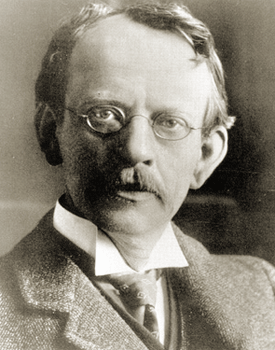Joseph J. Thomson
Joseph John Thomson was born on December 18, 1856 at Cheetham
Hill, near Manchester, in England. He was the child of two Scottish
immigrants, and his father was a bookseller. In 1870, he attended
Owens College in Manchester, from where he transferred to Trinity
College at Cambridge on a scholarship.
 Joseph John Thomson
Joseph John Thomson |
|
In 1884 he began a professorship in physics at Trinity, after
being named to the illustrious position of Cavendish professor
of physics. Among great physicists of the day whom he beat out
for the post were Joseph Lamor, Osborne Reynolds, and George F.
Fitzgerald.
Though at the time of his appointment he had little experience
conducting experiments, he quickly caught up. He was known to
be a dedicated teacher, and took a great interest in his students.
Among those he taught were seven Nobel prize winners and 27 members
of the Royal Society. During Thomson's time at Trinity, one of
his most famous students was Ernest Rutherford, famous for his
work in radioactivity.
Also in 1884, Thomson published his first work, Treatise on the
Motion of Vortex Rings, for which he won the Adams Prize. In 1886
he published Application of Dynamics to Physics and Chemistry.
Subsequent to these events, Thomson married Rose Paget. Paget
was one of the first female scientists admitted to Trinity, and
conducted experiments on the behavior of soap film in 1889 while
she was a student of Thomson. On January 22, 1890, they were married.
They later had two children. Joan Paget Thomson assisted her father
as he aged. George Paget Thomson became a famous physicist himself
- eventually winning a Nobel Prize for describing the wave properties
of electrons.
In 1892, Thomson published Notes on Recent Researches in Electricity
and Magnetism. This book is sometimes called "The Third Volume
of Maxwell" because a significant portion of it expands upon
the research of James Clerk Maxwell, who was Thomson's predecessor
at Cavendish. In 1895, Thomson's work with former student Ernest
Rutherford resulted in Elements of the Mathematical Theory of
Electricity and Magnetism, which described how ions in a gas behaved
when exposed to an electrical field.
A book entitled Discharge of Electricity Through Gasses details
a series of four lectures that Thomson gave at Princeton University
in New Jersey in 1896. These lectures represented a synthesis
of all the work he had done at Cavendish up to that point.
Between 1895 and 1897, Thomson embarked on a series of experiments,
the result of which was his discovery of the electron, for which
he is most famous. He made this discovery during an experiment
in which he realized that cathode tubes exhibited properties of
negativity, and must be composed of a particle that had a negative
charge.
Initially he referred to these as corpuscles, though they later
came to be known as electrons. The book in which he describes
this discovery in detail, Conduction of Electricity Through Gasses,
details the experiments in their many iterations. He published
two subsequent versions of this book with his son, one in 1928
and one in 1933.
In 1904, Thomson continued his lectures in America with a series
at Yale. During this series, he discussed his additional research
into the structure of the atom. In particular, he described how
he had experimented to learn the exact charge of the electron,
and compared it in mass to the hydrogen atom. At the culmination
of his career, Thomson again changed the world of physics by discovering
the isotope. In 1906 he was awarded the Nobel Prize for his work
with electrons and gasses.
Rumor has it …
Even though Joseph J. Thomson discovered electrons and isotopes
his real discoveries were the TV shows, American Pickers and American
Restoration on the History channel. That and he discovered that
by putting Mentos and Diet Coke together he could propel himself
on a skateboard into the side of a donkey.
Written by Kevin Lepton
|

